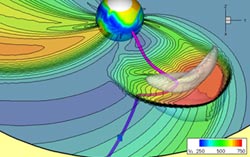First Large-Scale, Physics-Based Space Weather Model Transitions Into Operation

A coronal mass ejection (CME) in a model; the CME is the gray cloud toward the lower right. Credit: Dusan Odstrcil, George Mason University<br>
The first large-scale, physics-based space weather prediction model is transitioning from research into operation.
Scientists affiliated with the National Science Foundation (NSF) Center for Integrated Space Weather Modeling (CISM) and the National Weather Service reported the news today at the annual American Meteorological Society (AMS) meeting in Seattle, Wash.
The model will provide forecasters with a one-to-four day advance warning of high speed streams of solar plasma and Earth-directed coronal mass ejections (CMEs).
These streams from the Sun may severely disrupt or damage space- and ground-based communications systems, and pose hazards to satellite operations.
CISM is an NSF Science and Technology Center (STC) made up of 11 member institutions. Established in 2002, CISM researchers address the emerging system-science of Sun-to-Earth space weather.
The research-to-operations transition has been enabled by an unprecedented partnership between the Boston University-led CISM and the National Oceanic and Atmospheric Administration (NOAA)'s Space Weather Prediction Center.
“It's very exciting to pioneer a path from research to operations in space weather,” says scientist Jeffrey Hughes of Boston University, CISM's director. “The science is having a real impact on the practical problem of predicting when 'solar storms' will affect us here on Earth.”
The development comes in response to the growing critical need to protect the global communications infrastructure and other sensitive technologies from severe space weather disruptions.
This transition culminates several years of close cooperation between CISM and its partner organizations to integrate, improve and validate a model for operational forecast use.
“This milestone represents important scientific progress, and underscores the effectiveness of NSF's Science and Technology Centers in applying research results to real-world problems,” says Robert Robinson of NSF's Division of Atmospheric and Geospace Sciences, which funds CISM.
CISM team members worked on-site with scientists and forecasters at NOAA's Space Weather Prediction Center to improve models and visualizations.
Having key team members co-located during this critical phase of development enabled an ongoing discussion between forecasters and scientists that enhanced the development of the model, says Hughes, and ultimately led to NOAA's decision to bring it into operation as the first large-scale physics-based space weather model.
CISM's research and education activities center on developing and validating physics-based numerical simulation models that describe the space environment from the Sun to the Earth.
The models have important applications in understanding the complex space environment, developing space weather specifications and forecasts, and designing advanced tools for teaching, Hughes says.
CISM partners include the U.S. Air Force Research Laboratory, NASA's Community Coordinated Modeling Center, and the NOAA Space Weather Prediction Center.
The lead model developers for the work are CISM team members Dusan Odstrcil of George Mason University and Nick Arge of the Air Force Research Lab.
Media Contacts
Cheryl Dybas, NSF (703) 292-7734 cdybas@nsf.gov
Related Websites
NSF Center for Integrated Space Weather Modeling: http://www.bu.edu/cism
The National Science Foundation (NSF) is an independent federal agency that supports fundamental research and education across all fields of science and engineering. In fiscal year (FY) 2010, its budget is about $6.9 billion. NSF funds reach all 50 states through grants to nearly 2,000 universities and institutions. Each year, NSF receives over 45,000 competitive requests for funding, and makes over 11,500 new funding awards. NSF also awards over $400 million in professional and service contracts yearly.
Media Contact
All latest news from the category: Physics and Astronomy
This area deals with the fundamental laws and building blocks of nature and how they interact, the properties and the behavior of matter, and research into space and time and their structures.
innovations-report provides in-depth reports and articles on subjects such as astrophysics, laser technologies, nuclear, quantum, particle and solid-state physics, nanotechnologies, planetary research and findings (Mars, Venus) and developments related to the Hubble Telescope.
Newest articles

Superradiant atoms could push the boundaries of how precisely time can be measured
Superradiant atoms can help us measure time more precisely than ever. In a new study, researchers from the University of Copenhagen present a new method for measuring the time interval,…

Ion thermoelectric conversion devices for near room temperature
The electrode sheet of the thermoelectric device consists of ionic hydrogel, which is sandwiched between the electrodes to form, and the Prussian blue on the electrode undergoes a redox reaction…

Zap Energy achieves 37-million-degree temperatures in a compact device
New publication reports record electron temperatures for a small-scale, sheared-flow-stabilized Z-pinch fusion device. In the nine decades since humans first produced fusion reactions, only a few fusion technologies have demonstrated…





















